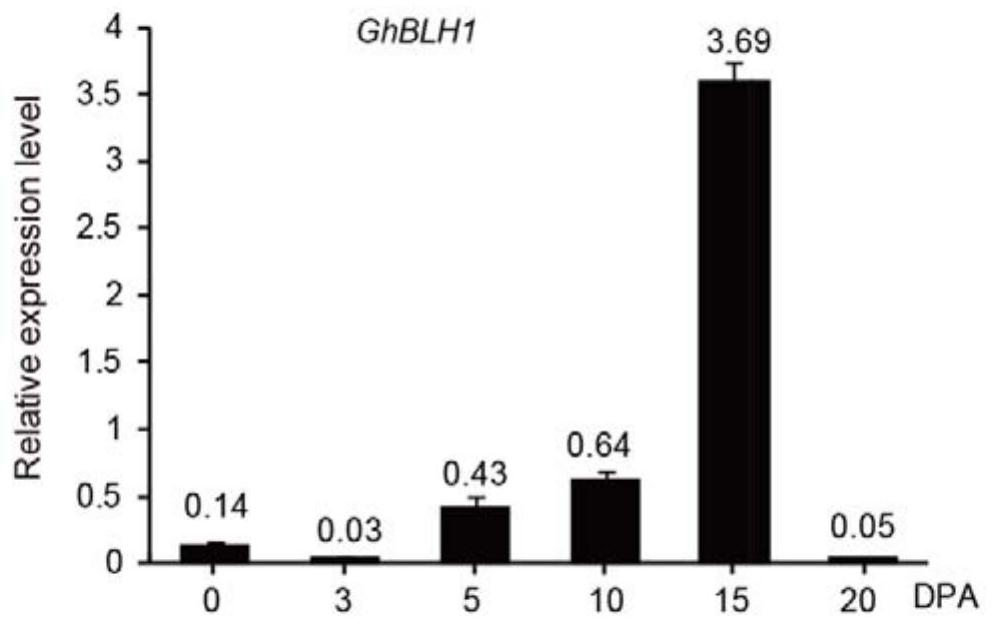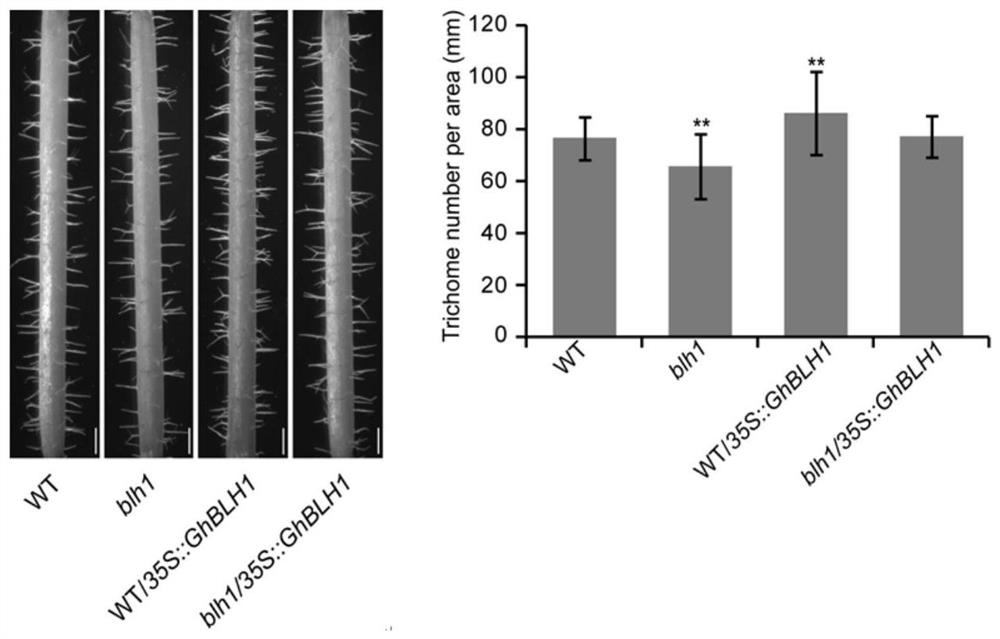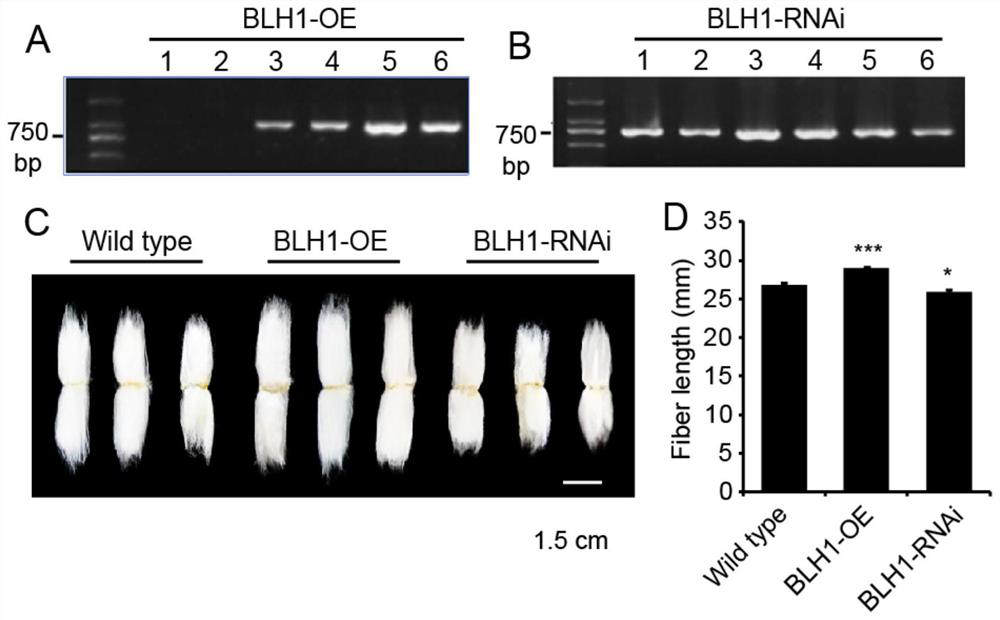Gene GhBLH1 for controlling fiber elongation of cotton and application of gene GhBLH1
A gene and transgenic cell line technology, applied in the field of cotton genetic engineering, can solve problems such as unclear gibberellin signaling pathways
- Summary
- Abstract
- Description
- Claims
- Application Information
AI Technical Summary
Problems solved by technology
Method used
Image
Examples
Embodiment 1
[0033] Example 1: Expression patterns of GhBLH1 gene at different stages of cotton fiber development
[0034] 1. Extract the RNA of 0DPA, 3DPA, 5DPA, 10DPA, 15DPA, and 20DPA fiber tissue in different stages of Xuzhou cotton 142 fiber development, reverse transcribe into the first strand cDNA, and design primers according to the dominant gene sequence, GhBLH1-QRT-F: C C A A GG A G T A G C G T C A A T G A G T and G h B L H 1-Q R T-R: C C A C T A C C G G TA T T A T C A G T T C C T for Q-PCR amplification.
[0035] 2. The procedure used to complete the above experiment was pre-denaturation at 95°C for 15s; denaturation at 95°C for 5s, refolding at 60°C for 34s, extension at 72°C for 40s (data receiving); a total of 40 cycles.
[0036] 3. The internal reference gene used to complete the above experiments is GhUBQ7, and the primer sequences are GhUBQ7-F: GGCATTCACCTGACCAACAA, GhUBQ7-R: CCGCATTAGGGCACTCTTTTC.
[0037] 4. For each of the above reactions, 3 biological repeats and 3 te...
Embodiment 2
[0040] Example 2: Phenotypic identification of GhBLH1 overexpression Arabidopsis and mutation complementation
[0041] 1. Construction of recombinant plasmid pBI121-GhBLH overexpression
[0042] 1. Use primers to amplify the target gene fragments, and the primer sequences are shown in the table below.
[0043] Primers were designed using the cotton genome (https: / / cottonfgd.org / ) sequence as a reference, and the full-length GhBLH1 gene was obtained by PCR amplification. Using the cDNA of cotton 15-day fiber (cotton fiber tissue after 15 days of cotton flowering) as a template, the full-length GhBLH1 gene with enzyme cleavage sites was amplified, and the first 9 nucleotides in the primers in the following table are protected bases and enzymes cutting site, the sequence of the target gene is underlined,
[0044]
[0045] 2. Homologous recombination method The target gene fragment was connected to the vector pBI121 to obtain the recombinant plasmid pBI121-GhBLH.
[0046] 3....
Embodiment 3
[0050] Example 3: Obtaining and Phenotypic Analysis of GhBLH1 Transgenic Cotton Plants
[0051] 1. Construction of recombinant plasmid pBI121-GhBLH overexpression
[0052] 1. Obtain the target gene fragment with primer amplification, and the primer sequence is the same as in Example 2.
[0053] Using the cDNA of cotton 15-day fiber as a template, the GhBLH1 gene fragment with vector homology arms was amplified.
[0054] 2. Homologous recombination method The target gene fragment was connected to the vector pBI121 to obtain the recombinant plasmid pBI121-GhBLH.
[0055] 3. Introducing the recombinant plasmid pBI121-GhBLH into Agrobacterium tumefaciens GV3101 to obtain recombinant Agrobacterium.
[0056] 2. Construction of recombinant plasmid pHellsgate4-GhBLH gene interference vector
[0057] 1. Amplify a specific fragment of an approximately 500bp target gene with primers comprising an adapter sequence.
[0058] 2. Connect to the RNAi interference vector pHellsgate4 by BPa...
PUM
| Property | Measurement | Unit |
|---|---|---|
| Length | aaaaa | aaaaa |
| Length | aaaaa | aaaaa |
Abstract
Description
Claims
Application Information
 Login to View More
Login to View More - R&D
- Intellectual Property
- Life Sciences
- Materials
- Tech Scout
- Unparalleled Data Quality
- Higher Quality Content
- 60% Fewer Hallucinations
Browse by: Latest US Patents, China's latest patents, Technical Efficacy Thesaurus, Application Domain, Technology Topic, Popular Technical Reports.
© 2025 PatSnap. All rights reserved.Legal|Privacy policy|Modern Slavery Act Transparency Statement|Sitemap|About US| Contact US: help@patsnap.com



